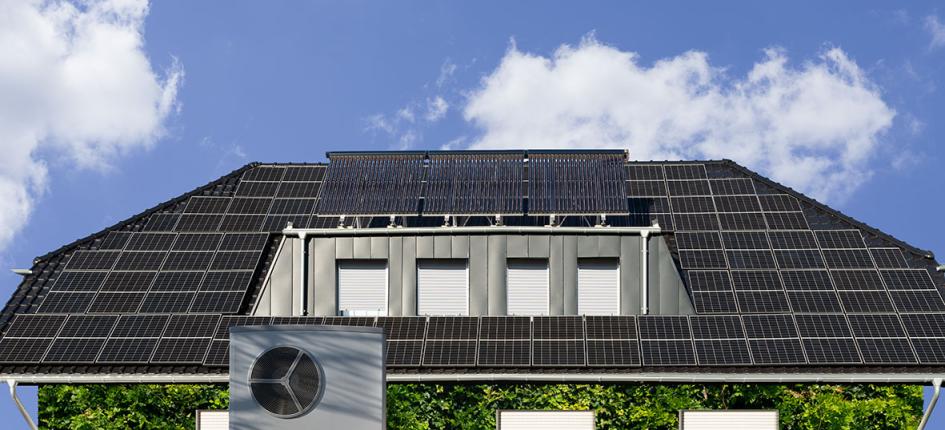Developments and innovations that can support the transition to a lower emissions society gain pace
Smart cities such as Toronto, Madrid, and New York City have enacted building energy efficiency and emissions regulations focusing on existing large buildings, but it will take national-scale efforts to achieve meaningful impact. Integration of renewable energy resources is well acknowledged in the net zero conversation, but as that’s a supply issue, achieving net zero in the right time frame requires a demand reduction effort, new retrofit technologies to improve efficiency of building heating, cooling, and insulation; along with process innovation methods for new construction such as prefabrication and design optimization software.
Heating & Cooling Innovation Enabling New Approaches to Building Upgrades
Between 35-40% of building-related emissions come just from heating and cooling, mostly HVAC. Although there are building performance requirements in many countries (e.g. the EU Energy Performance of Buildings Directive), by 2100 the global population exposed to deadly heat conditions is projected to grow by 50% - 75%, meaning that heating & cooling systems must perform better while also consuming less energy.
Much of the market-ready innovation today consists of frictionless software offerings that allow building managers to plug cloud software directly into a building management system (BMS) and start optimizing HVAC equipment immediately. This is indeed an approach being embraced by many owners of modern buildings or new builds, but retrofitting older buildings requires some element of either creating connectivity or optimizing at the device/component level. Indeed, the ubiquity of low-cost sensors, 5G, cloud computing, and accessible AI and machine learning have created a dynamic where mass digitalization is possible even for “dumb” buildings. Recent examples of standout innovation include:
• ExerGo (Switzerland) is developing an energy network using CO₂ flowing in a closed-loop network to transfer renewable heat from the environment or waste heat. The Swiss cleantech startup captured over $3 million in seed funding last autumn to commercialize its technology domestically and in broader Europe.
• US-based 75F is bringing customers a full stack of sensors and relays, modular to accommodate diverse device mixes in buildings and customizable to fit a building’s specific needs. 75F’s hardware enables devices to connect to a software platform that performs command-and-control, allowing a user to plug the devices and software into an existing BMS or to leapfrog the BMS altogether – an option that is especially useful for older or lower-tech buildings.
• Turntide Technologies (US) offers a novel electric motor and motor controller that can be retrofitted into HVAC equipment and self-optimize for maximum component-level efficiency. Turntide has raised over $300 million in the past 18 months and has expanded out in buildings to offer a full cloud solution for building management as well as making acquisitions and launching new products for electric mobility and agriculture.
• Heat pumps are increasingly becoming a go-to solution to replace gas boilers and other combustion-based heat sources in buildings. Netherlands-based Blue Heart Energy has created a thermoacoustic (sound wave-based) technology to replace refrigerants and reduce energy consumption of heat pumps.
Integrating Whole Life-Cycle Carbon into Deep Retrofits
For those in the construction industry, it is common knowledge that most of the technology underpinning retrofitting already exists, is readily available and is increasingly cost-effective. That doesn’t mean that innovation in the sector is stagnant. In fact, the paradigm of how to fully reach net-zero in the built environment is evolving to a Whole Life-Cycle Carbon methodology. This entails evaluating and quantifying a building’s operational carbon emissions from both regulated and unregulated energy use, as well as its embodied carbon emissions, i.e. those associated with raw material extraction, manufacture and transport of building materials, construction and the emissions associated with maintenance, repair and replacement as well as dismantling, demolition and eventual material disposal.
As knowledge trickles into policy and regulatory bodies around the world, we can observe innovators in the market respond to these drivers. Like HVAC, frictionless software offerings for architects and construction firms can be embedded in the blueprint and design stage to ensure these stakeholders select design solutions that have the lowest embodied and operational emissions. Other innovators have turned to novel concrete construction methods and prefabricated walls to streamline retrofits. Here are some fascinating examples:
• Fribourg-based developer of concrete 3D printing technology for construction, Mobbot, exploits aerodynamics of sprayed concrete combined with an automated robot. This not only enables locally sourced and recycled primary materials to be used but also lower quantities thereof. The startup has been able to make a significant impact in an industry that is relatively static in terms of innovation by logging real-time data and directly translating this into work in progress, effectively optimizing production, and reducing the amount of concrete used. Most recently, it was named Swisscom’s IoT Climate Award winner.
• Carbon Saver (France) is a provider of a SaaS building information modeling platform for architects and designers working on residential renovation. Its eco-design tool offers drawing software capable of providing more accurate calculations for insulation and waste management. It also generates an overall environmental impact score according to the French regulatory guidelines for construction and retrofits (RE2020). The early-stage company graduated from Gener8tor Luxembourg this year and is currently raising $1.5 million in non-dilutive funding from the French Public Bank of Investment.
• Neustark (Switzerland) is a developer of construction concrete from carbon dioxide and waste concrete. Having pioneered the rollout of four sites last year, the startup has proven that builders, architects, and construction engineers can reduce their carbon footprint using their concrete without any loss in quality. Currently in scale-up mode, the innovator is now rapidly expanding in Switzerland and across Europe on the road to storing one million tons of CO₂ in 2030.
• Berlin-based modular carbon retrofit startup, Ecoworks, raised over $8 million in its seed extension round this past summer. The innovator designs roof and facade elements that wrap around existing structures and act as a second skin. The Ecoworks platform employs digital 3D planning and prefabrication techniques that move up to four-fifths of retrofitting activities away from the construction site and into factories, where energy efficiency is maximized, and on-site renewables are more readily available.





